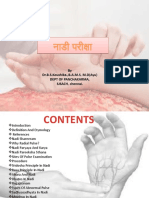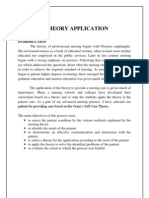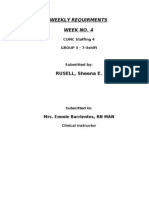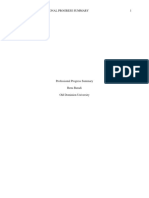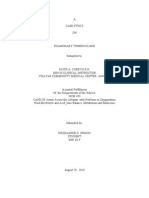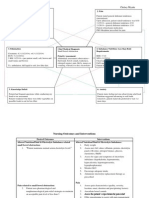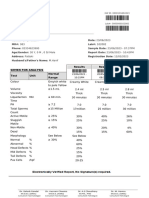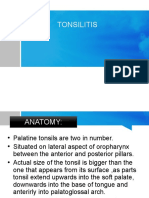0 ratings0% found this document useful (0 votes)
35 viewsKnodeweek 8 Ans 2 P
Knodeweek 8 Ans 2 P
Uploaded by
api-278552800The 78-year-old female patient was admitted with community-acquired pneumonia that led to sepsis, acute respiratory failure, and acute renal failure due to untreated pneumonia and hypotension. The patient was started on IV antibiotics and oxygen therapy but remained fatigued. The nursing goal was to wean the patient to lower oxygen levels, encourage deep breathing and coughing, and monitor urine output and respiratory status.
Copyright:
© All Rights Reserved
Available Formats
Download as DOC, PDF, TXT or read online from Scribd
Knodeweek 8 Ans 2 P
Knodeweek 8 Ans 2 P
Uploaded by
api-2785528000 ratings0% found this document useful (0 votes)
35 views3 pagesThe 78-year-old female patient was admitted with community-acquired pneumonia that led to sepsis, acute respiratory failure, and acute renal failure due to untreated pneumonia and hypotension. The patient was started on IV antibiotics and oxygen therapy but remained fatigued. The nursing goal was to wean the patient to lower oxygen levels, encourage deep breathing and coughing, and monitor urine output and respiratory status.
Original Title
knodeweek8ans2p
Copyright
© © All Rights Reserved
Available Formats
DOC, PDF, TXT or read online from Scribd
Share this document
Did you find this document useful?
Is this content inappropriate?
The 78-year-old female patient was admitted with community-acquired pneumonia that led to sepsis, acute respiratory failure, and acute renal failure due to untreated pneumonia and hypotension. The patient was started on IV antibiotics and oxygen therapy but remained fatigued. The nursing goal was to wean the patient to lower oxygen levels, encourage deep breathing and coughing, and monitor urine output and respiratory status.
Copyright:
© All Rights Reserved
Available Formats
Download as DOC, PDF, TXT or read online from Scribd
Download as doc, pdf, or txt
0 ratings0% found this document useful (0 votes)
35 views3 pagesKnodeweek 8 Ans 2 P
Knodeweek 8 Ans 2 P
Uploaded by
api-278552800The 78-year-old female patient was admitted with community-acquired pneumonia that led to sepsis, acute respiratory failure, and acute renal failure due to untreated pneumonia and hypotension. The patient was started on IV antibiotics and oxygen therapy but remained fatigued. The nursing goal was to wean the patient to lower oxygen levels, encourage deep breathing and coughing, and monitor urine output and respiratory status.
Copyright:
© All Rights Reserved
Available Formats
Download as DOC, PDF, TXT or read online from Scribd
Download as doc, pdf, or txt
You are on page 1of 3
Sepsis
IV Rocephin 1g in NS q24
hr; cephalosporin antibiotic,
disrupts bacterial cell wall
synthesis
Azithromycin 500mg in NS
q24hr; macrolide antibiotic,
interferes with bacterial
protein synthesis
Untreated pneumonia
results in secondary
problems including
sepsis and acute
respiratory failure
Pertinent Physical Examination findings:
Coarse, ronchi sounds bilaterally in lungs
Regular breathing pattern w/dyspnea w/exertion
Even chest expansion
100% SpO2 on 10L non-rebreather mask
100% SpO2 on 5L NC, 97% SpO2 on 4L NC
Productive cough, thin light brown sputum
Urine output 0-10mL/hr; amber, cloudy appearance
PO intake of 480mL
Poor appetite; active bowel sounds; last BM 3.5.14
Impaired gas exchange related to alveolar collapse
as evidenced by hypoxia and change in mentation.
Pt will maintain SpO2 above 94% during my shift.
Nursing interventions:
*Sat pt upright to promote chest expansion.
*Weened pt off 10L via non-rebreather to 4L via NC to
assist pt to breathe more effectively on her own.
*Taught pt incentive spirometer use and rationale to
encourage alveoli expansion.
*Encouraged coughing and deep breathing to cough up
mucus and promote breathing.
*Encouraged pt to suction secretions to promote
breathing.
Evaluation: Pt goal achieved.
Acute Renal Failure
Untreated pneumonia led to
sepsis, systemic
hypotension, poor perfusion
to the kidneys and
IV Rocephin 1g in NS q24 hr;
ultimately acute renal
cephalosporin antibiotic, disrupts
failure
bacterial cell wall synthesis
Azithromycin 500mg in NS q24hr;
(S.F, 78y.o. F)
macrolide antibiotic, interferes with
bacterial protein synthesis
Respiratory Failure
Former smoker,
pneumonia (community
acquired)
Acute
Pneumonia fluid build-up in the lungs alveolar
collapse poor oxygenation of the blood decreased
oxygen delivery to body systems poor perfusion
Healthline.com
IV Rocephin 1g in NS q24 hr;
cephalosporin antibiotic, disrupts
bacterial cell wall synthesis
Azithromycin 500mg in NS
q24hr; macrolide antibiotic,
interferes with bacterial protein
synthesis
10L O2 via non-rebreather 5L
NC 4L NC
Pt is visiting family in VA from NC. She was worried about her
daughter being able to attend to her bills and obligations back home. Pt
is preparing to move to VA from NC to be closer to family; stressful life
events may put stress on the pts mind and body, stress management and
a good family support system should be in place. Pt seemed very
worried about her family and taking care of her daughter, she may need
someone to help her focus more on herself and taking care of her health
over constantly worrying about others.
Taught pt incentive spirometry use and
rationale; taught pt deep breathing and
coughing; taught pt importance of sitting
upright; taught pt how to suction secretions
from back of throat; teach about medications,
disease process (how pneumonia led to sepsis,
acute renal failure); review diet plans (high
protein, small frequent meals)
Chest X-ray showed diffuse pneumonia,
especially in the R apex
WBC 38.1 HIGH pneumonia infection
RBC 3.44 LOW acute renal failure
HgB 9.7 LOW acute renal failure
Hct 29.2 LOW acute renal failure
BUN 44 HIGH acute renal failure
Cr 2.83 HIGH acute renal failure
Lactic acid 3.4
CO2 20 LOW acidosis r/t combination
1
of acute renal and respiratory failure
Guide for Reflection
Guide for Reflection Using Tanners (2006) Clinical Judgment Model
Introduction
This was my first week in critical care and I was taking care of a 78y.o F admitted with acute respiratory failure r/t
pnuemonia.
Background
I had no previous relationship with the patient. In past clinical experiences, I have taken care of patients in acute respiratory
failure. I was prepared to monitor her SpO2, respiration rate, listen to her lung sounds and assess for symptoms of hypoxia.
I was also prepared to teach her about incentive spirometry, deep breathing, coughing and repositioning. My role as the
nurse in this situation was to carry out previously described tasks, as well as to make the patient comfortable, assess her
pain and administer medications and prescribed. I did not have any strong emotions about the situation. Most emotions of
the day I had related to an anxious energy about my first critical care experience.
Noticing
Initially I noticed that my patient was awake, not on a ventilator, lying in bed with a non-rebreather mask on. As I read
through her chart I noticed that she was admitted for acute respiratory failure and that her lab values were all over the place.
When I first went in to assess my patient I realized she looked exhausted. She told me she hadnt slept at all and as I spoke
with her more she became more dyspnic and tired. As the day went on I realized that she was completely exhausted and
needed rest. I tried to go in and do some teaching about deep breathing and incentive spirometry, but she was so tired she
could barely get the spirometer to move. She was too tired to even eat. I sat with her and tried to feed her, but her secretions
were so thick and the effort to chew was so much that it seemed futile. I spent the rest of my day checking on her hourly,
monitoring her output and reminding her to suction out secretions from the back of her throat.
Interpreting
Her respiratory failure was related to pneumonia. Her untreated pneumonia further manifested as sepsis. The sepsis resulted
in systemic hypotension, decreasing perfusion to the kidneys which led the pt to experience acute renal failure. This posed a
problem because to treat sepsis, they flood the pt with fluids, and the pt was not putting any fluids out. Her urine output was
0-10mL/hr. As her nurse, my nurse advocated that my pts fluids be cut back and that nephrology be consulted. The
intensivist agreed and cut back on her fluids. I made it a priority to assess her respiratory status as well as her urine output. I
enjoyed working with my preceptor for the day because she really taught me how to connect the dots in pt assessment and
pt care. I gained valuable critical thinking skills from this experience.
Responding
My goal for this patient was to maintain SpO2 above 94%. In the morning she was maintaining 100% on 10L via nonrebreather. We received orders to cut this back to 5L via NC where she continued to maintain 100%. Later, we weened her
down to 4L and she was consistently at 97%. My goal from here was to teach her to use the incentive spirometer. The pt
was too exhausted to participate, but I would check in periodically and remind her how to use it. I kept her in an elevated
position and encouraged her to cough up secretions and to use suction as necessary. I was very comfortable teaching my
patient these interventions and was not stressed in any of my interactions with her. I was comfortable talking to her, helping
her with breakfast and lunch and felt comfortable in my assessment skills. The patient was receptive to me throughout the
day, she just seemed tired and like she needed to catch up on rest from being admitted over night that morning. As far as
monitoring her urine output, it ranged from 0-10mL/hr. The nurses expected this as did the doctors since she was septic and
hypotensive. All I felt that I could do in this situation was perform Foley care, monitor output and chart my findings.
Reflection-on-Action and Clinical Learning
One way my nursing skills expanded in that I learned about the nurses role in a critical care setting. Another way my skills
expanded is that I was able to observe patients on ventilators. One last way my skills expanded is that I got a lot of
experience with IV meds and helped my nurse hang FFP for my pt. One thing I might to differently in this situation is
engage the doctors more. They seemed open and willing to talk to us and help us learn. Another thing I would do differently
is be more engaged in my surroundings. One pt kept going into VTach and instead of going in the room immediately I kept
watching the EKG screen at the station. Another way I would change my practice is that I would try to be more comfortable
with my surroundings. I was overwhelmed initially, not knowing what to expect and it wound up being a great learning
experience. I didnt have anything to be afraid of. Critical care nursing is definitely a different beast than MedSurg nursing.
I would love to expand my skills with the vents and trachs and suctioning skills and tube feeding process. Expanding my
repertoire of nursing skills would definitely help in this kind of nursing setting. As a result of this experience I gained an
appreciation for higher level nursing skills, critical thinking skills and ACLS prepared nurses. The nurses were more
engaging, possessed higher levels of thinking and acted professionally on a multidisciplinary team.
Nielsen, A., Stragnell, S., & Jester P (2007). Guide for reflection using the Clinical Judgment
Model. Journal of Nursing Education, 46(11), p. 513-516.
List two goals for the next practicum experience:
1. Learn differences between VCU and Bon Secours Health Systems
2. Gain appreciation for how the VCU ER functions
You might also like
- CASE STUDY Intestinal ObstructionDocument68 pagesCASE STUDY Intestinal ObstructionMaria Paula Bungay91% (23)
- Peds-vSim - Guided Reflection Questions - Jackson WeberDocument3 pagesPeds-vSim - Guided Reflection Questions - Jackson WeberCarole NesbitNo ratings yet
- By Dr.B.S.Koushika.,B.A.M.S, M.D (Ayu) Dept of Panchakarma, SJSACH, ChennaiDocument55 pagesBy Dr.B.S.Koushika.,B.A.M.S, M.D (Ayu) Dept of Panchakarma, SJSACH, ChennaiAyurvriksha100% (5)
- Case Reflection 25321902Document8 pagesCase Reflection 25321902Santhi Swetha PudhotaNo ratings yet
- Clinical ExemplarDocument5 pagesClinical Exemplarapi-302383914No ratings yet
- Dilated Cardiomyopathy Case StudyDocument29 pagesDilated Cardiomyopathy Case Studydvalitz100% (2)
- Clinical Narrative Level 4Document3 pagesClinical Narrative Level 4api-258141893No ratings yet
- Theory ApplicationDocument38 pagesTheory ApplicationAnusha VergheseNo ratings yet
- Soap Note1 - Gyn ComplaintDocument6 pagesSoap Note1 - Gyn Complaintapi-482726932100% (3)
- AMOEBIASISDocument44 pagesAMOEBIASISJorge Rabaja100% (1)
- CARCINOGENESIS CRC Prof RiwantoDocument48 pagesCARCINOGENESIS CRC Prof Riwantoand3sgr3atNo ratings yet
- wk4 Weekly Self Eval KmiuraDocument3 pageswk4 Weekly Self Eval Kmiuraapi-295640482No ratings yet
- Wse Week5Document4 pagesWse Week5api-302336744No ratings yet
- ReflectionDocument9 pagesReflectionVino VinnoliNo ratings yet
- AcutecareharrisonblackDocument2 pagesAcutecareharrisonblackapi-315402591No ratings yet
- Chang CAse StudyDocument20 pagesChang CAse Studycharlene_00996No ratings yet
- Weekly Requirments Week No. 4: RUSELL, Sheena EDocument17 pagesWeekly Requirments Week No. 4: RUSELL, Sheena ESheena Echavez RusellNo ratings yet
- Reflective Theories Writing AssignmentDocument7 pagesReflective Theories Writing Assignmentapi-582889983No ratings yet
- ReflectionDocument2 pagesReflectionapi-283689862No ratings yet
- Professional Progress SummaryDocument16 pagesProfessional Progress Summaryapi-272878167No ratings yet
- Adult Health Reflective JournalDocument11 pagesAdult Health Reflective Journalapi-721737905No ratings yet
- Hospice Care PlanDocument9 pagesHospice Care PlanAmanda SimpsonNo ratings yet
- Clinical ExemplarDocument4 pagesClinical Exemplarapi-272451466No ratings yet
- Clinical ExemplarDocument3 pagesClinical Exemplarapi-301881424No ratings yet
- Olasehinde Care StudyDocument46 pagesOlasehinde Care Studyolasehindemodupe3No ratings yet
- Untitled Document - Edited - 2024-05-31T005318.985Document2 pagesUntitled Document - Edited - 2024-05-31T005318.985OdeteNo ratings yet
- Nursing Management of A Patient With: HyperthyroidismDocument31 pagesNursing Management of A Patient With: Hyperthyroidismember parkNo ratings yet
- Critical CareDocument5 pagesCritical Careapi-353947564No ratings yet
- ANCDocument36 pagesANCmandeep ataliaNo ratings yet
- Chapter 5Document4 pagesChapter 5CG Patron BamboNo ratings yet
- Weekly Requirement OB WardDocument12 pagesWeekly Requirement OB WardXerxes DejitoNo ratings yet
- Reflection PaperDocument6 pagesReflection Paperapi-733165948No ratings yet
- CccasestudyintropageDocument3 pagesCccasestudyintropageapi-252070005No ratings yet
- Competency AppraisalDocument4 pagesCompetency AppraisalKhriz Tin0% (1)
- School of Nursing and Allied Medical Sciences: Holy Angel UniversityDocument19 pagesSchool of Nursing and Allied Medical Sciences: Holy Angel UniversityMonica BorjaNo ratings yet
- Case Study - OTITIS MEDIADocument9 pagesCase Study - OTITIS MEDIAHasing Amado100% (1)
- Artifacts For PortfolioDocument4 pagesArtifacts For Portfolioapi-548205221No ratings yet
- Reflection On Resuscitation of NewbornDocument3 pagesReflection On Resuscitation of NewbornSaira raoNo ratings yet
- Kaltsasah 2 IntroDocument6 pagesKaltsasah 2 Introapi-384506632No ratings yet
- "Don't Take My Breath Away" A Case Presentation On Pneumocystis PneumoniaDocument20 pages"Don't Take My Breath Away" A Case Presentation On Pneumocystis PneumoniaNikki DiocampoNo ratings yet
- Acute Decompensated Heart FailureDocument58 pagesAcute Decompensated Heart FailureAeloran Jullienne Cailles (Aelora Jullienne)No ratings yet
- batool AHN.docx (5)Document8 pagesbatool AHN.docx (5)Muhammad UmarNo ratings yet
- Clinical Exemplar Good OneDocument5 pagesClinical Exemplar Good Oneapi-259394980No ratings yet
- DischargeplanningDocument6 pagesDischargeplanningapi-288858560No ratings yet
- Clinical ExemplarDocument5 pagesClinical Exemplarapi-456852298No ratings yet
- SOPIEDocument16 pagesSOPIEshing_1987No ratings yet
- F2F MeaslesDocument7 pagesF2F MeaslesMichelle Gliselle Guinto MallareNo ratings yet
- ADocument20 pagesADivinity Ü NicaNo ratings yet
- Mental Health Assessment Paragraph WeeblyDocument2 pagesMental Health Assessment Paragraph Weeblyapi-241839714No ratings yet
- Clerk GCPDocument19 pagesClerk GCPNikki DiocampoNo ratings yet
- ClinicalexemplarpdfDocument5 pagesClinicalexemplarpdfapi-314696212No ratings yet
- Acute Care Final Reflective Journal 2018 - Jamie BorelDocument4 pagesAcute Care Final Reflective Journal 2018 - Jamie Borelapi-431213859No ratings yet
- Desired OutcomesDocument4 pagesDesired Outcomesapi-302415380No ratings yet
- Objectives For Critical Care RotationDocument9 pagesObjectives For Critical Care Rotationsteviestevie333No ratings yet
- Preeclampsia, Severe, UncontrolledDocument22 pagesPreeclampsia, Severe, UncontrolledLharra Cagulada-PostranoNo ratings yet
- Pro MetricsDocument129 pagesPro MetricslianausinNo ratings yet
- Clinical ExamplarDocument6 pagesClinical Examplarapi-433705780No ratings yet
- Posting ElectiveDocument7 pagesPosting ElectiveThulasi tootsieNo ratings yet
- NCP n360 CmiyakeDocument5 pagesNCP n360 Cmiyakeapi-273088419No ratings yet
- Case Study 1Document29 pagesCase Study 1Patricia Ann Salazar Rn100% (3)
- Beat Chronic Disease - The Nutrition Solution: Use Funactional Nutrition to Recover Your HealthFrom EverandBeat Chronic Disease - The Nutrition Solution: Use Funactional Nutrition to Recover Your HealthNo ratings yet
- Slides For SeizureDocument15 pagesSlides For SeizureBryan Mae H. Degorio100% (3)
- 983 - Ashiq Hussain - Laboratory ReportDocument2 pages983 - Ashiq Hussain - Laboratory ReportshehnazdiagnosticlabNo ratings yet
- Blood TransfusionDocument55 pagesBlood Transfusionanand7504100% (2)
- Epistaxis Thesis Lekshmi DEVI - 045602Document27 pagesEpistaxis Thesis Lekshmi DEVI - 045602Bhavya R Krishnan100% (1)
- Government College of Nursing MSC (N) 1 ST YEAR (2019-2021) Research Proposal PresentationsDocument4 pagesGovernment College of Nursing MSC (N) 1 ST YEAR (2019-2021) Research Proposal Presentationsvani reddy100% (1)
- TERAPIA NUTRICIONAL EN SEPSIS WischmeyerDocument21 pagesTERAPIA NUTRICIONAL EN SEPSIS WischmeyerHéctor Juárez GrandaNo ratings yet
- Sarcomas: Chondro Ewing's Sarcoma Fibro SarcomaDocument23 pagesSarcomas: Chondro Ewing's Sarcoma Fibro SarcomaRawda NajjarNo ratings yet
- Jurnal TiroidektomyDocument5 pagesJurnal TiroidektomyPap PipNo ratings yet
- Donabedian Model 2022Document23 pagesDonabedian Model 2022emmahpkemoi5No ratings yet
- Which of The Following Goals Is Correctly WrittenDocument13 pagesWhich of The Following Goals Is Correctly WrittenKaye CorNo ratings yet
- Interpreting Histograms ABX 00198R1Document2 pagesInterpreting Histograms ABX 00198R1nguyenphuongphoebeNo ratings yet
- Tonsil EditDocument29 pagesTonsil EditDwi Utari PratiwiNo ratings yet
- AssessmentDocument1 pageAssessmentkushishaNo ratings yet
- Sleep Disorders (Diasomnia) : Diasomnia - Difficulties Falling Asleep or WakingDocument11 pagesSleep Disorders (Diasomnia) : Diasomnia - Difficulties Falling Asleep or Wakingfunny-arianNo ratings yet
- Investigation of EpidemicDocument74 pagesInvestigation of EpidemicSivaNo ratings yet
- AbdulHamid NothingNewSun 2014Document10 pagesAbdulHamid NothingNewSun 2014Andrei LeconaNo ratings yet
- PDF Copy Haematology Laboratory Manual Cls 241 PDFDocument70 pagesPDF Copy Haematology Laboratory Manual Cls 241 PDFKahina Ould TalebNo ratings yet
- Module No. 2 Drug Dosage and CalculatioonsDocument7 pagesModule No. 2 Drug Dosage and CalculatioonsJellie An TalattagNo ratings yet
- Cyst Lump Mass Tumor+questionnaire ApplicantDocument2 pagesCyst Lump Mass Tumor+questionnaire Applicantjanel norbeNo ratings yet
- P1Document12 pagesP1Roykedona Lisa TrixieNo ratings yet
- Teknik Konseling November 2012Document70 pagesTeknik Konseling November 2012ramadhanaristaNo ratings yet
- 2020 Selected Occupational Therapy CPT CodesDocument5 pages2020 Selected Occupational Therapy CPT CodesJane DNo ratings yet
- Actual Pages 1-2Document6 pagesActual Pages 1-2tyron veranoNo ratings yet
- Faktor Risiko Kejadian Arthritis Gout Pada Pasien Rawat Jalan Di Rumah Sakit Dr. Wahidin Sudirohusodo, MakassarDocument8 pagesFaktor Risiko Kejadian Arthritis Gout Pada Pasien Rawat Jalan Di Rumah Sakit Dr. Wahidin Sudirohusodo, MakassarEster DewNo ratings yet
- A - LAPORAN PENDAHULUAN - KELOMPOK A (New)Document12 pagesA - LAPORAN PENDAHULUAN - KELOMPOK A (New)Fahira SalsabilaNo ratings yet
- Nervous SystemDocument3 pagesNervous SystemshhhNo ratings yet
- Paida and Lajin Self - Healing (Hongchi Xiao 2012)Document44 pagesPaida and Lajin Self - Healing (Hongchi Xiao 2012)rajaleidur100% (7)
- Osteoporosis - 2022 CanvasDocument61 pagesOsteoporosis - 2022 CanvasSHEILA HADIDNo ratings yet


